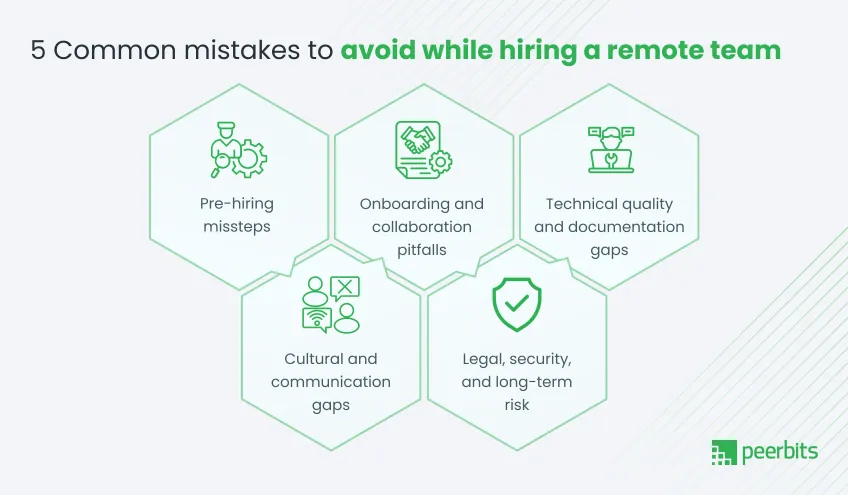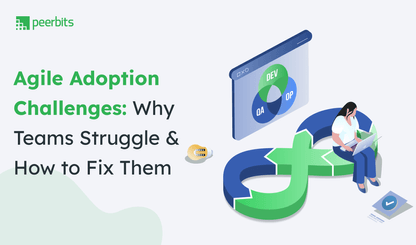Hiring a remote tech team has become a common way for startups to get started. It helps you build faster, cut costs, and find skilled people. For many early-stage companies, it is a practical option when in-house hiring takes too long or for some it is not possible.
But it only works when done with the right strategy. Founders often fall into common traps like choosing based on price, skipping technical checks, or setting vague expectations. These quiet mistakes can delay your releases, inflate budgets, and create more problems than they solve.
These 5 common remote hiring mistakes show up more than you had expected. Knowing how to spot and prevent them can save you time and money.

1 Pre-hiring missteps
Hiring a remote team without proper planning often leads to mistakes that cost more than they save. Before you start the remote hiring process, here are the most common issues to watch for.
Choosing low cost over startup experience
One of the common pitfalls of hiring remote developers is focusing only on price. Startups often go for the lowest bid to save money early on, but this usually backfires. Developers without startup experience often struggle with fast timelines, changing priorities, and lean workflows.
Fix: Look for developers who have worked on MVPs, handled early-stage builds, or delivered under tight sprint cycles. When you are hiring a remote team with proven startup experience, you are paying for fewer delays and less rework later.
Skipping checks on past work
Another mistake to avoid when hiring remote team members is trusting the portfolios without asking the right questions. It is about how a project looks and how it was delivered. Was it completed on time? What kind of support was provided post-launch? How responsive was the team?
What to ask:
- What types of projects have you built recently?
- Were you involved in the full cycle or just one part?
- How did you handle deadlines and changes?
- Can I speak with a past client?
So, know that you know what to ask, you should also be aware of what to avoid.
Red flag: Anyone who avoids giving references or examples from past projects. Why? Because solid teams are always open to sharing feedback and their client success stories.
Hiring before defining your actual needs
Founders sometimes start hiring before knowing what kind of developers they need. You might bring on a full-stack developer when your current task only needs frontend work or hire DevOps help too early in the product cycle.
This is a mistake to avoid when building a remote team, when every hour counts.
Fix:
- Map out your product’s key features
- Define core user flows
- Decide whether you need frontend, backend, mobile, or infrastructure help
- Set short-term milestones
When you are clear on your scope, it gets easier to hire remote teams for your startup without confusion or wasting your time.
Read more: Reduce Software Development Costs by Hiring Dedicated Developers
2 Onboarding and collaboration pitfalls
Good developers can still produce poor results if the onboarding is weak or collaboration is chaotic. This is the reason, many software outsourcing projects slip. From mismatched time zones to missing documentation, these issues block progress before the work begins.
Weak onboarding leads to poor output
Remote developers do not know your business, product goals, or end users unless you walk them through the details.
Fix: Set the tone early. Share a simple onboarding doc that covers product vision, target users, and KPIs. Then run a kickoff call with intros to key stakeholders and a walkthrough of the current roadmap. This helps everyone align from day one.
No overlap in working hours or unclear response expectations
If your developers are working while you are sleeping, blockers sit idle for hours. And if no one’s defined what “ASAP” really means, you’ll face delays.
Fix: Agree on a few overlapping work hours and define response windows for blockers, updates, and code reviews. Just 2–3 shared hours daily can keep momentum strong and avoid long standstills.
Using too many or too few tools
Chaos starts when you are juggling six platforms or on the flip side, tracking progress in email threads.
Fix: Keep it simple. Slack or MS Teams for communication. Jira or Trello for project tracking. GitHub or Bitbucket for version control. That’s enough to keep your remote teams aligned without tool fatigue.
3 Technical quality and documentation gaps
A rushed hiring decision often skips over the most basic checkpoints like testing, documentation, and technical handovers. Over time, these turn into recurring issues for your internal teams.
Whether you are hiring a remote development team or building one in-house, clear standards upfront save you from expensive rework later.
No technical screening or test project
Many businesses hire software developers based on their portfolios and calls alone. But without a technical screening round or even a basic test project, you are only guessing their skills. This can result in buggy code, missed expectations, or slow onboarding.
Fix: Make testing non-negotiable. Add a live coding task or paid trial sprint before any long-term commitment. If you are working with a custom software development company, ask to review the developer’s screening process in detail.
Skipping documentation and handover clarity
You might get working code, but without proper documentation or a handover checklist, it becomes kind of a one-person dependency. If that developer leaves or goes offline, your internal team spends days reverse-engineering what was done.
Fix: Push for documentation from the beginning. Code comments, setup guides, and API references should be part of every sprint. When you hire a remote development team, ask how they handle project transfers and what’s included in their handoff package.
Lack of clear coding standards or version control
When every developer follows their own style or uses outdated version control practices, things break fast. Especially in distributed teams, lack of consistency in code structure, comments, or Git workflows creates confusion and slowdowns.
Fix: Define your coding standards. Make sure the remote team follows naming conventions, testing rules, and uses proper Git branches. If you are not confident, ask for a sample repo or audit a recent commit history before signing the contract.
4 Cultural and communication gaps
Cultural gaps and unclear communication can slow things down or shift projects off course. When developers are not aligned with your work habits or hesitate to clarify doubts, the delays and confusion add up quietly.
Hiring teams who don’t understand your market
Let’s say you are building a fintech MVP for a US-based audience, but your remote developers are not familiar with local compliance rules or how US users typically behave. You will end up spending more time fixing the gap than shipping the product.
Fix: Share detailed user personas, expected workflows, and any country-specific standards from day one. Don’t assume they’ll figure it out.
Communication mismatches or lack of proactiveness
It’s not about following instructions. The best remote teams speak up. They suggest improvements, flag potential issues early, and don’t wait to be told every step.
What to look for: Teams that give structured weekly updates, ask smart questions, and maintain a steady feedback loop. Silence is usually a red flag.
Read more: When not to hire remote developers
5 Legal, security, and long-term risk
Hiring without legal clarity or proper security layers can cost you more money and it risks your product, IP, and trust.
No formal contract or IP agreement
Some founders skip contracts, especially when hiring through referrals or freelancing platforms. That’s risky. Lock down NDAs, IP ownership, timelines, and payment terms before any work begins. A clear agreement protects both sides and avoids messy handovers later.
Ignoring data security and access control
Never give full access blindly. Add access control layers, enable activity logs, use a VPN, and separate staging from production. One common issue? Freelancers pushing untested changes straight to live servers. Set clear roles and review flows from day one to avoid these surprises.
These five mistakes often trip up companies during the hiring phase, but what happens after that? Once the contracts are signed and the team’s onboard, a new set of risks can appear.
Let’s walk through the post-hiring and long-term mistakes that quietly drain productivity, budgets, and even trust.
Post-hiring and long-term mistakes
Hiring a remote team is only the start, but the bigger challenge is what happens after onboarding. Some startups nail the hiring part but fall short in retention, internal alignment, or even product direction.
No retention strategy for top developers
If there’s no clear growth path, regular feedback loop, or transparency in how their work impacts the business, even your best engineers will eventually lose interest. Remote devs crave clarity, just like in-house teams.
Set up consistent check-ins, include them in sprint reviews, and highlight their wins across the team.
Not building internal accountability
Even with a remote development team in place, founders can’t step out of the driver’s seat. Building a product still needs strong prioritization, code reviews, and ongoing product validation.
If no one is leading with intent, the team ends up shipping features that don’t move the needle. Remote or not, accountability starts at the top.
Expecting remote teams to fix a broken business idea
Hiring remote developers won't solve fundamental issues like poor product-market fit, vague user problems, or lack of early traction.
The team can execute, but if the vision is blurry, results will be too. A remote setup can only work if the foundation is solid.
Conclusion
Hiring remote developers is about finding the right talent and building the right setup from the beginning. Missteps in hiring may lead to miscommunication, poor productivity, or projects that stall halfway.
These 5 common remote hiring mistakes to avoid act like a checklist for staying on course. Fix the gaps early, get clarity on expectations, and set up solid communication from the start. That’s how you avoid future fire-fighting and build a remote team that consistently delivers.

FAQs
Some common cost surprises include third-party integrations, security audits, ongoing server expenses, and version updates for new OS releases. It's smart to keep a buffer for these.
Depending on complexity, it can take anywhere from 2 to 6 months for most apps. Enterprise-level platforms or apps with advanced tech like AI may stretch beyond that.
Yes. Using cross-platform frameworks like Flutter or React Native lets you build for both platforms with shared code, which can cut development time and cost.
Yes. Start with an MVP, avoid overengineering, pick the right tech stack, and outsource to skilled developers in regions with better cost-efficiency.








